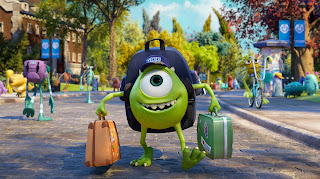Director: Dan Scanlon
Writers: Daniel Gerson, Robert
L. Baird, Dan Scanlon
Ever since Pixar was taken over
by Disney in 2006, something seems to have been happening with their films.
Once they were making fascinatingly experimental and pretty out-there films
like WALL-E and Up, but now one can't help
wondering if the businessmen have started to take over. Any news now concerns
sequels, with both Cars 2 and Monsters University coming
out, and Finding Dory on the way. Considering just how
poor Cars 2 was, having followed the already
slightly disappointing Cars,
it's easy to think all this is just a project to shift as much merchandise as
possible. But we can't forget Pixar is no stranger to sequels, having made the
brilliant Toy Story 2 and 3. So how will they fare in the
world of the prequel?
Monsters University charts the story of Mike
Wazowski (Billy Crystal) and James P. "Sully" Sullivan's (John
Goodman) friendship from college up to the first film, when they're the top
scarers at Monsters Inc. Mike, inspired to become a scarer after a school trip
to Monsters Inc. as a cute six year old, works hard to get to university,
despite not being a natural scarer. It all comes easily to Sully on the other
hand, who lazily assumes he can make it without working. When an incident puts
both of their places at uni at risk, they have to work together to win the
prestigious Scare Games and get back on track.
The best Pixar films create
vast new worlds and within that populate it with rich lovable characters that
have to complete a simple quest. From Finding
Nemo’s race across the vast ocean to save a lost fish to The Incredible’s 1950’s inspired comic
book adventure, they’ve shown how wonderfully it can be done. Monsters University definitely gets the
first parts right. Everyone still loves Mike and Sully from their first
adventure, and the campus in the film is an incredible sight, with a whole
array of beautifully rendered monsters of all shapes and sizes. As you’d
expect, every frame is simply gorgeous to look at.
The problem lies with the plot.
What starts as a simple idea quickly multiplies into a rambling set of
unoriginal set pieces, all relying too heavily on sports movie and college
movie clichés. Like Homer Simpson says after watching too many of these films: “There
are two kinds of college students- jocks and nerds. As a jock, it is my duty to
give nerds a hard time.” Things are no different here, with Mike and Sully
trapped on the side of the nerds, fighting against the world. All the action
takes place on campus and, bar one scene venturing to Monsters Inc. itself,
this severely restricts the film’s potential to explore exciting new settings
and ideas like we know Pixar can do so well. These restrictions, and the sheer
fact it’s a prequel, mean it’s not exactly hard to guess how Monsters University will progress which
sometimes makes it hard to care.
 But overall, does that really
matter? Even substandard Pixar is so much better than the vast majority of
animations out there, especially now it’s possible for any studio to create
quick, cheap-looking computer generated cartoons easily. The amount of love and
care that has gone into making this is as obvious as any of the other films. On
top of that, it’s still a pretty funny film making good use of their
tried-and-tested word play, visual humour and self-referential pastiche.
But overall, does that really
matter? Even substandard Pixar is so much better than the vast majority of
animations out there, especially now it’s possible for any studio to create
quick, cheap-looking computer generated cartoons easily. The amount of love and
care that has gone into making this is as obvious as any of the other films. On
top of that, it’s still a pretty funny film making good use of their
tried-and-tested word play, visual humour and self-referential pastiche.
Monsters
University is still a lot of fun to watch, and increasingly rarely in
cartoons these days, a film that absolutely everybody can enjoy, here avoiding
slipping into crude innuendo and knowingly nudge-and-wink territory designed to
keep adults interested in films appealing only to kids. This doesn’t need that;
Pixar still have that wonderful ability to make everyone feel like big kids
again. It’s just disappointing when you think they can, and have done, so much
better than this before. At the very least, it looks so much better than Planes, Disney’s new cash-cow tie-in to Cars. Plus Pixar’s next projected
projects, The Good Dinosaur and Inside Out, both sound extremely
promising.




.jpg)

















